|
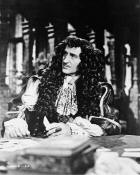 This lavish production of Daphne du Maurier's novel
tells the story of Lady Dona St. Columb finding true love for the first
time in her life. The
setting is England in 1668, during the reign of Charles II. In
those days noblemen wore ridiculous-looking long curly wigs. It's quite
amusing to see Basil Rathbone and Nigel Bruce wearing these wigs! This lavish production of Daphne du Maurier's novel
tells the story of Lady Dona St. Columb finding true love for the first
time in her life. The
setting is England in 1668, during the reign of Charles II. In
those days noblemen wore ridiculous-looking long curly wigs. It's quite
amusing to see Basil Rathbone and Nigel Bruce wearing these wigs!
The story starts in London where Lady St. Columb is
attending a party with her dull-witted husband Harry. At the party Harry's
best friend Lord Rockingham (Rathbone) flirts with Lady St. Columb. Dona
St. Columb was a woman who was trapped in a loveless, passionless
marriage, and therefore sought excitement by drinking in the taverns with
her husband's friends and the women of the town. At one time she and
Rockingham pulled a prank on an old lady, so now "Rock" has the audacity to try to seduce her. Although Dona is
bored with her husband, she's not interested in Rock and cannot endure his
familiarity. She hates her senseless
life, and who she has become. One night she decides she has had enough;
she packs her bags and takes her two small children and the nanny to their
country manor Navron on the coast of Cornwall.
For the next few weeks Dona enjoys her new-found freedom,
playing with her children and exploring the countryside around Navron. Her
peace is only interrupted once by a visit from Lord Godolphin (Nigel
Bruce), her pompous dunderhead neighbor, to warn her that pirates have been terrorizing the people along the
coast. One day while walking through the woods on her property Dona
discovers a large ship at anchor in a pool where the
creek widens. The creek is still and soundless, shrouded by the trees—the
perfect hiding place for a pirate ship. Dona meets the Frenchman. Since he
was a pirate, she had expected him to be evil, leering, dirty, greasy, and was baffled to find him not at all like that.
He is a gentleman, who has become a pirate to escape the ordinary life of
a gentleman. In the novel the pirate has a name; he is Jean Benoit Aubéry,
from Finesterre in Brittany. His name is not mentioned in the film, but
when Dona finds a French book in her bedroom, we see the inscription
"J.B.A." and beneath that "Finesterre."
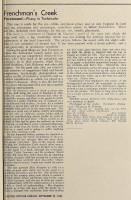 Frenchman's Creek Frenchman's Creek
Paramount—Piracy in Technicolor
This one is made for the eye—blithe storybook piracy and ye
olde England by land and sea, picaresque and picturesque, sometimes
quaint, in fullest Technicolor. There are bits, including close
harmony, for the ear, too, sweetly glamoured.
The story is a treatment of Daphne
du Maurier's novel of the same title which did very well with a big
readership which was not looking for exercise beyond the
requirements of the tired housewife. The picture follows the novel,
with the slight addition of one scoundrel of deepest dye. It has
been painted with a lavish pallette, and a vast generosity in
production treatment.
Among the good things are Joan
Fontaine, to whom to the Technicolor camera makes love in terms any
eye can comprehend; Arturo de Cordova, who's been much in the
newsprints and measures up to their promise; Nigel Bruce, Basil
Rathbone, Cecil Kellaway and other able players. On the good side,
also, are interiors and exteriors of magnificent kind and heroic
proportions, fascinatingly photographed, and such a wealth of
costumery, properties and expensive impedimenta as seldom are placed
at a producer's disposal. There is also the fact that it's a sheer
entertainment film sent into a market requiring entertainment.
Miss du Maurier's novel is about a
pirate who did his stuff along the coast of England in 1664, when
the men of England dressed and often behaved like women, and that's
a far period in which to interest a public thinking now of England
as a very different kind of place. In short, it's a costume picture,
a period play, and the action in it does not resemble what goes on
in the same area now. The pirate is a sweet sort of fellow, courtly
and gallant like the ones in children's picture books, and he does
his swashbuckling almost totally by word of mouth and in the past
tense. Others profess to be afraid of him, but he gives the audience
no reason for being so, and there's never a moment when anyone can
doubt the the lovely lady who sails with him on a small raid is
going to suffer anything worse than catching a cold.
As has happened before, perhaps for
identical or similar reasons, the heroic proportions of the
production itself are stronger than the story about the people
concerned. One of the reasons might be that the Production Code
doesn't allow even a 17th-century pirate to wax as devilish as he
does in the pages of a book, although the screenplaywright, Talbot
Jennings, and the producer, David Lewis, did what they could about
this by supplying another character with lust enough for a scene
such as hasn't been screened since two-reeler villains used to chase
heroines 'round and 'round the parlor furniture.
The tale presents Miss Fontaine as
wife of a noble no-good who wants her to be sweet to a gambling pal
with a yen for her. She declines and goes to her country place, near
which is parked a French pirate whose cut-throats sing lovely songs
in close harmony, and the two of them get together romantically with
the collaboration of a servant who's a jewel of understanding. She
disguises herself as a boy and goes with the pirate on a raid, a
dialogue line explaining later that nothing not nice takes place
between them, but after they get back the pirate is captured and she
has to fenagle an escape for him. That accomplished, she tells him
she can't go one with him because she's got two children who need
her so he goes on out to sea again—a decidedly unpunished though
charming criminal—and that's that. Meanwhile, she's
killed her husband's pal by throwing a suit of armor in his face as
he chases her up the stairs at close of the attack scene mention
above; and nothing's done about that, either, up to the time the
picture fades out. Maybe later.
Exploitation that emphasizes the
names of the distinguished personnel, the magnitude of production
and the lavishness of its Technicolor, appears assured to get a
maximum number of customers in to see the picture. It's been so long
since they've had a pirate picture to look at, and this is such a
big one.
Mitchell Leisen directed with
deliberation and vast attention to detail.
Reviewer's Rating: Good.
—William R. Weaver.
—Motion Picture Herald, September 23, 1944 |
With the
gallant Frenchman as tutor, Dona learns about birds and fishing, and learns to love the simple life.
She feels light-hearted, happy and peaceful. Because they are both fugitives, there is a bond between Dona and the Frenchman. Both wanderers, cast in the same mould. They fall in love.
When the Frenchman sails to steal ship from a town up the coast, Dona
sails with him and is thrilled with the adventure. The Lady St. Columb who sups cheek by jowl with the ladies of the
town and later roisters about the streets of London no longer exists.
After Dona's return from the plundering of the ship, she
learns to her dismay that her husband and Lord Rockingham have arrived at
Navron. Not only are they breaking her peace, but they are gathering the
men of the nearby towns and setting a trap for the Frenchman! Dona sends
William, her servant, to the ship to warn the Frenchman to sail right away
to avoid capture. William returns with the distressing news that the ship
is grounded and cannot sail until after midnight. Since the men are
gathering for dinner at Navron before going out to hunt the pirate, Dona
determines to keep them at the table as long as possible. She keeps their
wine glasses full and entertains them.
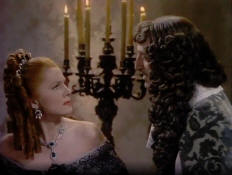
Rock thinks he is irresistable. |
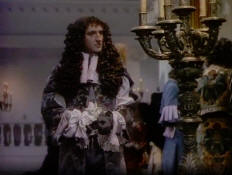
Gotta love that wig! |
For some unexplained reason Lord Rockingham is not
wearing a wig at dinner, but all the other men do. Dona is charming with her guests,
even Rock, whom she despises. Rock flirts with Dona, as though he wishes every man at
the table to believe he makes love to her.
Arriving
at the manor at midnight the Frenchman and his crew surprise Dona's
dinner guests and take their weapons. Rock sees the way Dona looks at the
Frenchman and, with his uncanny intuition, he realizes that she loves the
pirate. The men are tied up and the Frenchman takes Dona into the salon to
talk with her privately. While Dona and the pirate talk, the Cornish
noblemen manage to loosen their bonds and slip out the window after the
pirates—except for Rockingham, who returns to the dining room to confront
Dona about her lover. Watching her like a cat watching a bird, he says to
her, "I understand much that has puzzled me since I came here
yesterday. That servant of yours, those walks in the woods, that elusive look in your eye that I
have never seen before, yes indeed, elusive to me, to Harry, to all men but one man, and I've seen that man tonight."
He looks at her with hatred.
She doesn't deny it, acts indifferent, and taunts Rockingham: "And all this my
dear Rockingham because you imagine I smiled upon a pirate when he asked for my jewels."
 "Frenchman's Creek" "Frenchman's Creek"COSTUME DRAMA RICH IN
ROMANCE AND SWORD PLAY IS ESCAPIST STUFF WITH B.O. PUNCH.
"Frenchman's Creek," derived from the Daphne du Maurier
best-selling novel of the same name, is a romantic tale of the days
of Charles II of England that is escapist entertainment of the first
grade. Produced in the grand manner and impressive in its physical
aspects, the picture should prove a solid click at the box office.
Under the watchful eyes of Executive Producer B.G. DeSylva and
Associate Producer David Lewis, the film resolves itself into a
Technicolor spectacle that employs hues with stunning effect. The
story never loses its interest as it moves from one dramatic
incident to another in its course of high adventure.
While the tale holds the women with its story of the love of an
English noblewoman for a bold, dashing pirate from the shores of
France, it bids for the attention of the men with its display of
violent action in which sword play figures prominently.
The chief scene of action is the Cornish Coast. It is there that
Joan Fontaine, as the lady of high estate seeking an escape from the
stupid and dull life of London society, meets Arturo de Cordova, the
pirate lover. Much of the action has to do with the efforts of the
English gentry to capture the pirate and string him up. Miss
Fontaine has her brief moment of happiness with de Cordova, her duty
to her children (she's married to Ralph Forbes) compelling her to
part from him at the end.
Miss Fontaine and de Cordova enact the lovers satisfactorily.
Basil Rathbone, Nigel Bruce, Cecil Kellaway are others who stand
out.
Mitchell Leisen directed the Talbot Jennings screenplay with
distinction.
DIRECTION, Fine. PHOTOGRAPHY, Superb.
—The Film Daily, September 20, 1944 |
Rockingham threatens Dona with being hanged along with the pirate, and she doesn't care.
He says, "Yes, you would suffer that, wouldn't you, and be glad, because you've had, at last, the
love you've wanted all your life."
She admits this is true and Rockingham goes berserk. "If you hadn't
left London and come down here," he hisses, "it would have been me!" "Never!" she
cries.
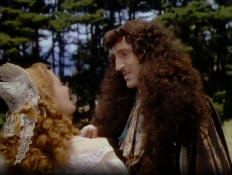
Dona and Rockingham at Navron |
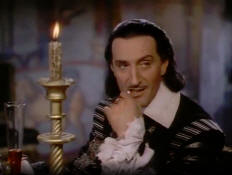 |
Rockingham lunges at her, trying to strangle her. She
manages to grab a knife and stab him, and then runs to the stairs. Even
though he's badly wounded, Rockingham struggles to crawl up the stairs after
Dona. In the novel Dona throws a heavy shield at him; in the movie she
pushes over a suit of armor. Either way Rockingham is knocked down and killed.
When Sir Harry returns, he is aghast to find Rock dead.
Harry thinks that Rock died defending Dona against the pirate. In the book she never corrected him.
But in the film she says right away, "I killed Rockingham ... I had
to. I warned you to keep him away from me." Harry also informs Dona
that the Frenchman has been captured and will hang in the morning.
Dona St. Columb concocts an ingenious plan to rescue
the Frenchman, and he believes she is going to sail with him back to
Brittany. But in the end Dona decides she cannot leave her children, even
though she loves the Frenchman, and it breaks her heart to watch him sail
away.
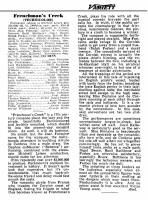 Frenchman's Creek Frenchman's Creek"Frenchman's Creek" is a
17th century romance about the lady and the pirate, beautifully
Technicolored and lavishly mounted, which should fit into the
present-day escapist idiom. As such, it will do business.
No smash, but the Joan Fontaine name for the marquee, the
ballyhoopla attendant to building Arturo de Cordova into a male
draw, the Daphne duMaurier ("Rebecca") authorship, combined with the
elaborate Mitchell Leisen production, should make for b.o.
attention.
Film reputedly cost over $3,000,000 to produce. Paramount's
costliest investment in history. It doesn't quite look that
expensive, but it's understandable that much back-of-the-scene
travail and delay could fast mount the costs.
The romantic pirate from France who invades the Cornish coast of
England, hiding his frigate in what thus becomes known as
Frenchman's Creek, plays his role with all the musical comedy
bravado the part calls for. In truth, if the public accepts the
cinematurgy in that frivolous, musicomedy manner, the picture is a
cinch to become a winner.
The romance is supposedly forthright and played straight. Miss
Fontaine seeks refuge in the Cornish castle to get away from a
stupid husband (Ralph Forbes) and a ducal menace. The scoundrelly
servant at the Cornish retreat is actually the pirate chief's
hireling, and the romance between the two, including a de-Haysized
idyll on his piratical schooner over-night, is but one of a sequence
of similar adventures.
All the trappings of the period are interlarded in this tale of
hijacking an English pirate's vessel, loaded with booty from the
Indies; bearding the irate English gentry in their lair; duelling
against odds; the inevitable arrest and escape to the high seas,
leaving Miss Fontaine and de Cordova mooning at each other through
the sails and halliards. It is a romantic picture of love torn
asunder by the conventions are her two children.
The performances are sometimes unconsciously tongue-in-cheek, but
withal come off well. Cecil Kellaway is particularly good as the
servant. Miss Fontaine is beauteously titian and desirable as the
romantically torn wife, and de Cordova gets his role off well albeit
not altogether convincingly. He has yet to prove himself truly socko
as a male pash. Nigel Bruce, Basil Rathbone and Forbes are otherwise
satisfactory, especially Bruce. Rathbone is too leeringly the
lecherous menace, and Forbes too much the dolt.
The scripting at times borders on the ludicrous, especially when
almost all the sympathetic figures wax near hysteria in their
scoffing at the dangers which may beset them. Productionally it is
ultra. And no minor assist is that excellent Victor Young score.
Abel.
—Variety,
September 20, 1944 |
This drawing by Feg Murray shows a scene from
Frenchman's Creek in which Dona manages to stab Rockingham in the
back:
|
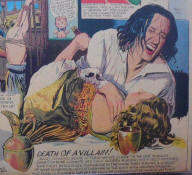
Caption:
Death of a Villain! Most dramatic scene in "Frenchman's Creek" is
the one in which Joan Fontaine commits her first screen murder (but
in self defense). She first bites Basil Rathbone in the hand, then
throws a goblet of wine in his face; next, stabs him in the back
with his own dagger, and finally finishes him off by hurling a heavy
suit of armor on him. |
|